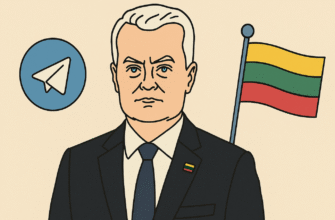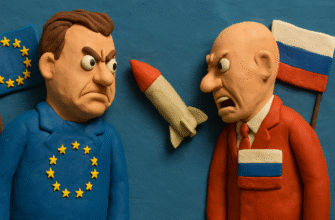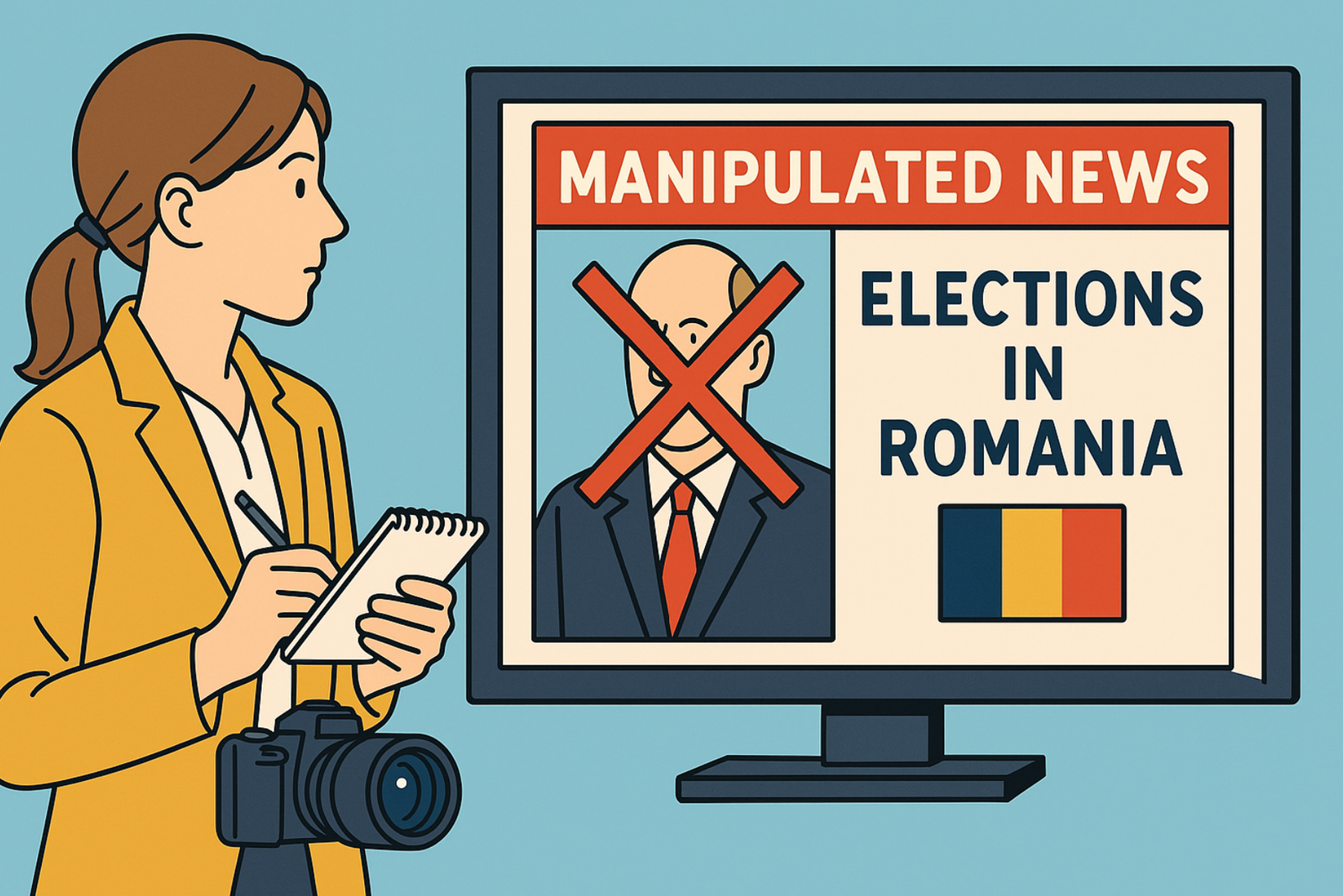The topic of the Republic of Kosovo is often used in Belarusian Telegram channels.
Methodology A dataset of mentions of Kosovo and Pristina in Belarusian Telegram was collected for the period from January 1, 2024, to October 9, 2024. The total number of posts during the study period was 476.

The peak of publications and views occurred in March 2024 in connection with the 25th anniversary of NATO’s participation in the bombing of Serbia.
All publications were labeled and categorized. Most posts about Kosovo contain disinformation about the Republic of Kosovo. Belarusian propagandists, like their Russian counterparts, use the Kosovo issue to justify both the invasion of Ukraine and other aggressive actions of the Russian Federation. A large number of publications are related to Serbia’s foreign policy with neighboring countries, which involves constant blackmail of neighboring states, using Serbian minorities to destabilize the situation and increase tensions in the Western Balkans region.
Most of the publications were made by well-known toxic Telegram channels:
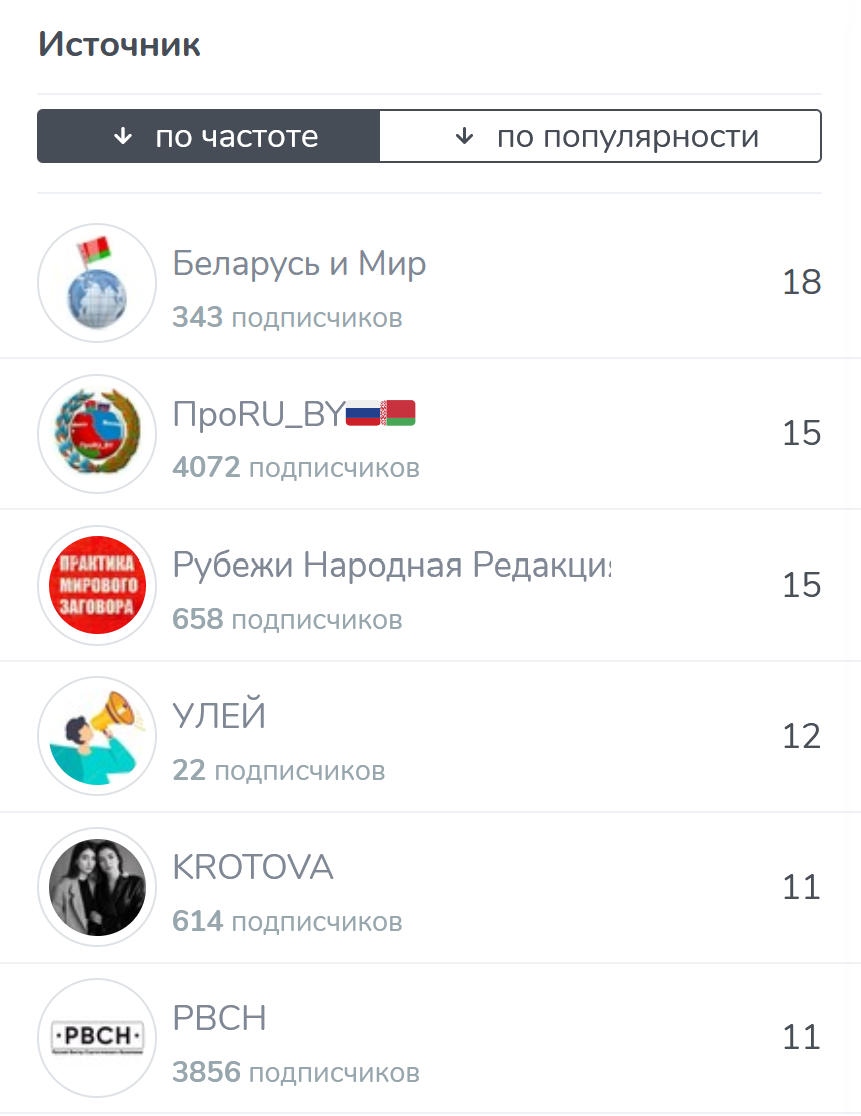
Let’s provide a brief historical overview of events in Kosovo and how they can be misinterpreted by Russian propaganda. Timeline of Events in Kosovo in 1999
- January 1999: Massacre in Račak
- On January 15, a massacre of Albanians took place in the village of Račak, which became a turning point in the international response to the Kosovo crisis. Serbian authorities claimed it was an operation against Kosovo Liberation Army (KLA) militants, but independent observers (e.g., OSCE) interpreted it as a massacre of civilians.
- Russian propaganda often describes this incident as fabricated or a provocation by the West to justify military intervention.
- February – March 1999: Rambouillet Negotiations
- In February, negotiations began in Rambouillet aimed at resolving the conflict. Kosovo Albanians agreed to the proposals, which included expanded autonomy for Kosovo, while Serbian authorities rejected the agreement, especially due to the potential deployment of NATO peacekeeping forces in Serbia.
- Russian propaganda often portrays Serbia’s refusal as “defending sovereignty,” emphasizing the unreasonable demands of NATO.
- March 24, 1999: Start of NATO Bombing
- After the failure of negotiations, on March 24, 1999, NATO began bombing Yugoslavia without UN Security Council approval. The bombings continued until June and included strikes on military and civilian targets. Officially, the goal was to stop ethnic cleansing in Kosovo.
- Russian media often characterize this moment as “illegal aggression by the West” against a sovereign state and highlight the “double standards” in international politics, emphasizing civilian casualties and infrastructure destruction.
- April – June 1999: Escalation of the Humanitarian Crisis
- During NATO air strikes, about 850,000 ethnic Albanians were forced to flee their homes to escape violence. Yugoslav military and police forces were involved in systematic ethnic cleansing, leading to numerous crimes against humanity.
- In Russian propaganda, the main focus is on the suffering of the Serbian population, while the scale of ethnic cleansing is downplayed or justified.
- June 12, 1999: Russian Forces Seize Pristina Airport
- On June 12, Russian airborne troops, having moved in advance from Bosnia, unexpectedly arrived in Pristina and took control of the airport before NATO forces arrived. Russian soldiers hoisted Russian flags, replacing the flags of the KFOR peacekeeping mission. This event created tension between Russia and Western countries, which did not anticipate such a maneuver.
- Russian propaganda views this incident as a successful demonstration of Russia’s determination to defend Serbia’s interests and counter the West.
- June 10, 1999: End of Bombing
- After the signing of an agreement on the withdrawal of Yugoslav troops from Kosovo, NATO bombings ceased on June 10. An international mission under the auspices of the UN was deployed in the region to maintain security and restore order.
- Russian propaganda sometimes describes these events as the beginning of foreign occupation control over Kosovo, depriving the region and Serbia of sovereignty.
- Post-1999: Formation of UN Mission and KFOR Deployment
- After the end of the conflict, Kosovo became effectively independent under the administration of the UN mission (UNMIK), with support from KFOR peacekeeping forces. In 2008, Kosovo declared independence, recognized by many countries, but not by Russia and Serbia.
- Propaganda often describes this as the illegal separation of Kosovo from Serbia and emphasizes the “betrayal” of the West in violating international law.
- 1995: Srebrenica Massacre (Context for Understanding Balkan Conflicts)
- In July 1995, in Srebrenica, a town in Bosnia and Herzegovina, a massacre took place, recognized by international organizations as genocide. Over 8,000 Bosnian Muslims, mainly men and boys, were killed by Serbian forces. This was one of the worst episodes of the Bosnian War and highlighted the inability of international forces (including the UN) to protect civilians.
- This context is important for understanding the tensions in the Balkans and the international community’s response to events in Kosovo. Russian propaganda often mentions Srebrenica in the context of criticizing NATO, claiming that international forces intervened selectively and failed to prevent humanitarian catastrophes.
Elements of Disinformation in Russian Propaganda
- Distortion of Events in Račak: Russian media often claim that the massacre in Račak was staged by the West to justify intervention in Kosovo. They question the objectivity of international observers and accuse them of bias.
- Describing NATO Bombing as “Aggression”: NATO strikes are called “illegal aggression,” with an emphasis on civilian casualties to discredit Western countries and present them as a threat to peace.
- Ignoring Ethnic Cleansing Against Albanians: Propaganda focuses on the suffering of the Serbian population while practically ignoring the scale of ethnic cleansing and crimes committed by Yugoslav forces against Kosovo Albanians.
- Using Srebrenica to Weaken Criticism of Serbian Actions: Propaganda tries to justify Serbian forces’ actions in Kosovo by referring to the inability of international organizations to prevent mass killings in Srebrenica, presenting Serbs as the only defenders of their people.
- Portraying Kosovo as “Occupied by the West”: It is emphasized that the international mission and subsequent independence of Kosovo were imposed, serving as an example of Western “colonialism.”
KFOR
Russian propaganda often tries to portray NATO forces in the most negative light, and one common narrative concerns the alleged violent experiences of these soldiers gained in previous conflicts. In particular, propaganda focuses on the claim that many soldiers participating in the KFOR mission had previous combat experience involving violence and killings.
This portrayal pursues several goals:
- Creating an Image of Aggressors: NATO soldiers are described as professional “killing machines,” implying their readiness for violence and suppression of civilians. This helps create fear and mistrust among the Serbian population and the general public.
- Discrediting the Peacekeeping Mission: NATO peacekeepers, who were supposed to ensure security and stability in Kosovo, are portrayed not as protectors but as a potential threat. This undermines the legitimacy of the international mission and creates the impression that NATO intervenes for coercion and control.
- Contrasting “Heroic” Serbian Soldiers with “Brutal” Western Forces: In the Russian narrative, Serbian forces are often presented as defenders of their land and people, while NATO soldiers are depicted as aggressors whose main goal is suppression and show of force.
In reality, KFOR forces consisted of representatives from various countries, many of whom participated in missions exclusively for the purpose of ensuring security and stabilizing the situation in conflict zones. Peacekeepers underwent special training aimed at minimizing risks to civilians and maintaining law and order.
You can find KFOR news here.
Let’s provide examples of the most characteristic publications with misinformation from the selected categories.
Of course, the topic of KFOR received the largest number of publications, with 69 posts in the analyzed dataset. These posts were related to various countries whose military personnel participated in the Kosovo peacekeeping mission. It was found that toxic Telegram channels selectively described the participation of soldiers in KFOR. If it was about Russian military personnel, they were portrayed as demonstrating the power and significance of the Russian Federation and providing substantial assistance to the Serbian people, although it is more correct to speak of the leaders of Serbia who faced punishment in international judicial bodies. On the other hand, soldiers from NATO countries are depicted as participants in “combat actions,” “ruthless killers who not only know how to kill but also love to do so.” As in this publication:

In this text, several disinformation narratives and distortions are identified, aimed at forming a negative perception of the actions of Polish authorities and their border policies with Belarus. Let’s consider the main elements: 1. Manipulation of Facts and Creating an Exaggerated Threat
- “Clashing with significantly increased acoustic effect” — the use of such expressions creates an image of aggressive and senseless military activity by Poland, aimed at exaggerating the threat and causing alarm among the audience.
- “17,000 soldiers” — the number of soldiers is presented without context, creating an impression of excessiveness and aggressive intent on the part of Poland, ignoring possible reasons for such mobilization, such as border protection and migration control.
2. Depicting Poland as a Repressive State
- “Polish military want to unleash the full might of their war machine on poor Middle Eastern migrants” — emotionally charged language is used here to create an image of Poland as a cruel and inhumane state seeking to use military force against defenseless migrants.
- “Polish soldiers are allowed to shoot at refugees to kill” — this serious statement creates an image of Poland as a country using lethal force against peaceful migrants, but without providing evidence. This statement may be false and aimed at inciting fear and distrust.
3. Distorting Statements and Creating an Image of Violent Reaction
- “Anyone who insults soldiers will face consequences” — an official statement is presented in a distorted way, creating the impression that any minor action against the military will be met with violence.
- “Responding to spits with machine-gun bursts?” — this hyperbole is aimed at forming a negative image of Polish soldiers as ruthless enforcers, ready to resort to unjustified violence against civilians.
4. Demonizing Security Forces and Distorting Their Role
- “Ruthless killers who not only know how to kill but also love to do so” — Polish police officers who participated in international missions are portrayed as brutal and aggressive individuals, aimed at creating fear and distrust towards Polish security structures. This statement ignores the real role of international peacekeeping missions and gives a deliberately demonizing tone to their participants.
5. Creating an Image of Incompetence and Fear
- “Terrified of the arrival of Wagner PMC fighters in Belarus” — this part of the text portrays Poland’s actions as a reaction of fear and panic, showing Polish authorities as indecisive and incompetent. This is an attempt to discredit Polish leadership and their actions regarding border security.
- “Drove a whole pack to the border” — derogatory language is used to describe Poland’s actions and military mobilizations, aimed at creating a negative attitude among the audience towards these events and portraying them as senseless and excessive.
6. Sarcasm and Undermining the Significance of Polish Operations
- “Operation ‘Safe Podlasie’ is plagiarism” — the text tries to mock and undermine the actions of the Polish government, using sarcasm and claiming they are repeating themselves without sense or purpose. This is an attempt to discredit Poland’s efforts to maintain border security.
Thus, the text contains several disinformation narratives and distortions aimed at demonizing Polish authorities, military, and security forces, as well as creating a perception of excessiveness, cruelty, and incompetence in Poland’s actions. The text uses emotionally charged language, hyperbole, sarcasm, and deliberate misrepresentation of facts to form a negative perception of Poland’s border security efforts.
NATO in 1999 In the collected dataset, a large number (54) of disinformation posts were related to NATO’s operation in 1999. A very characteristic publication by the main Belarusian librarian, as well as a member of the National Assembly of the Republic of Belarus — Vadim Gigin:

Let’s analyze an alternative version of Western Balkans history for disinformation narratives: This text contains numerous disinformation narratives and historical distortions that are deliberately aimed at forming a specific perception of Western countries as enemies harboring irrational hatred towards Serbs. 1. Biased Interpretation of Events and Accusation of Aggression
- “NATO unleashed aggression against Yugoslavia” — the text claims that NATO’s actions were aggressive and illegal; however, NATO’s operation was conducted to prevent ethnic cleansing in Kosovo and was the result of diplomatic failure to stop the violence. The operation was supported by many international acts and organizations.
- “The war is the culmination of a unipolar world” — this statement concludes that the war against Yugoslavia was part of a global strategy to establish Western control, which oversimplifies and distorts the causes of the conflict.
2. Creating a “Victim” Image and Using Emotional Narratives
- “The West hates Serbs” — this claim is based on fact distortion and emotional rhetoric. It forms an image of collective hatred of Western countries towards Serbs, simplifying and demonizing the goals and actions of Western countries, attributing to them “infernal hatred.” This is a classic example of using an enemy in disinformation campaigns.
- “Tito was friendly, and the West supported the Ustasha” — this claim distorts historical facts, depicting the CIA as a sponsor of the Ustasha, which is inaccurate and aimed at discrediting Western intelligence services. This narrative aims to create an image of the West as an enemy that consistently and deliberately opposed the Serbs and Yugoslavia.
3. Distorting Facts About Slobodan Milošević and Yugoslavia
- “Milošević was not an enemy of the West and loved his people” — this narrative attempts to portray Milošević as a moderate leader with peaceful intentions who was unfairly demonized by the West. It ignores Milošević’s role in fueling nationalism, ethnic cleansing, and escalating violence in the Balkans.
- “The West destroyed Yugoslavia” — the text claims that Germany and Western countries specifically provoked the collapse of Yugoslavia, whereas the breakup was actually the result of multiple internal contradictions, economic crisis, and the rise of nationalism in various republics.
4. Manipulating Victims and Crimes
- “Serbs suffered no less than others” — this statement attempts to equalize the suffering of all sides while downplaying the role of Serbs in ethnic cleansing and other war crimes. Western propaganda is supposedly demonizing Serbs, which is a distortion, as crimes during the Balkan wars were recognized by international tribunals and concerned not only Serbs but also other sides.
- “The US and EU stoked separatism in Montenegro” — the text claims that Montenegro’s independence was the result of a Western conspiracy, ignoring the will of Montenegrin citizens and their desire for independence, as expressed in the referendum.
5. Creating a Religious Narrative and Anti-Western Sentiment
- “Serbs are Orthodox, and therefore the West hates them” — this statement uses the religious factor to create a narrative about cultural and religious conflict between the West and Serbs. It distorts historical reality and fails to recognize the many other factors that influenced events in the Balkans.
- “Infernal hatred towards Serbs” — using terms like “infernal” helps create an image of irrational evil supposedly inherent in Western political culture, reinforcing anti-Western sentiments among the audience.
6. Conspiracy Theory
- The text clearly contains elements of a conspiracy theory, in which the West is accused of deliberately destroying Yugoslavia, hating Serbs, and supporting “anti-Serb” movements, which is unsupported by facts and is used to demonize the opponent.
Thus, the text contains numerous disinformation narratives and distortions aimed at creating an anti-Western perception and justifying aggressive policies. Emotional appeals, manipulation of facts, and creating an image of an external enemy are used to form a collective sense of resentment and hatred.
New Kosovo On April 14, 1999, in the midst of the conflict, Alexander Lukashenko visited Yugoslavia.

Perhaps this is one of the reasons for his regular use of the phrase “new Kosovo” when making predictions about new armed conflicts and areas of tension, including Belarus. Of course, the fault lies with NATO countries, the “collective West.” Just last week, a conspiracy theory was raised again about the Polesian Republic.
Visa Regime Perhaps this post aims to show how many more countries Belarusian passport holders can enter compared to those with a passport from the Republic of Kosovo.
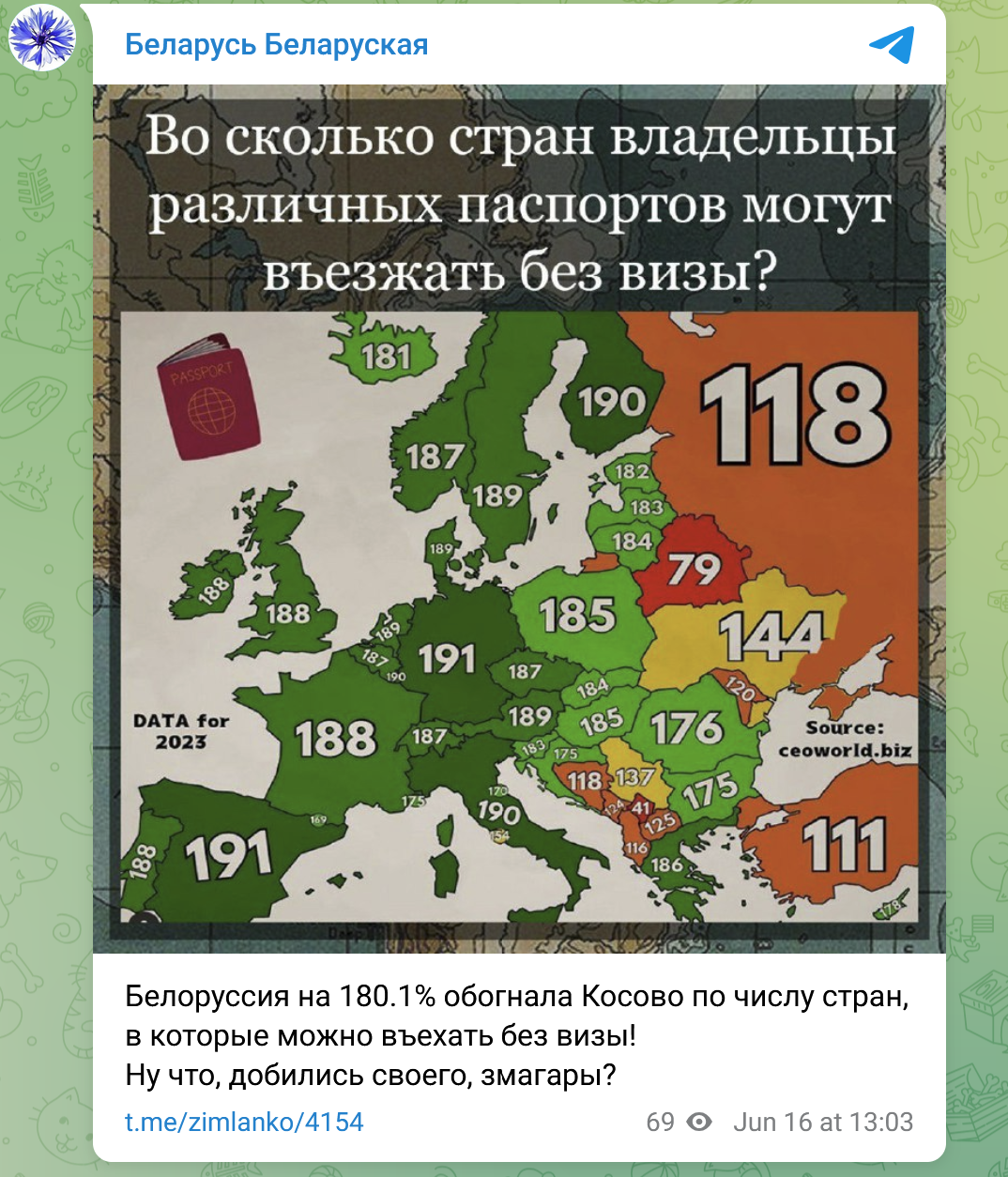
But as of January 1, 2024, Kosovo citizens can travel visa-free to Schengen countries. Kosovo is still unable to become a member of the UN (Serbia, Russia, and China disagree with this decision), but the country is recognized by 110 countries worldwide (Belarus is not among them). Five EU member states have still not done so. These are Spain, Greece, Cyprus, Romania, and Slovakia. Back in April 2023, it became known that Spain, despite general agreements, would not begin allowing Kosovo citizens to enter visa-free.
Economy The latest Economic Report of the World Bank for the Western Balkans predicts the region’s economy to grow by up to 3.2% in 2024, with further acceleration to 3.5% in 2025, approaching pre-pandemic levels. Growth is driven by the stabilization of international prices, sustainable remittances from the diaspora, and increased investments, especially in Kosovo, where GDP is expected to grow by 3.7% in 2024, associated with continued stabilization of international prices, sustainable remittances from the diaspora, and a gradual increase in investments. Despite positive forecasts, risks remain related to geopolitical tensions, domestic political instability, and weakening global growth.
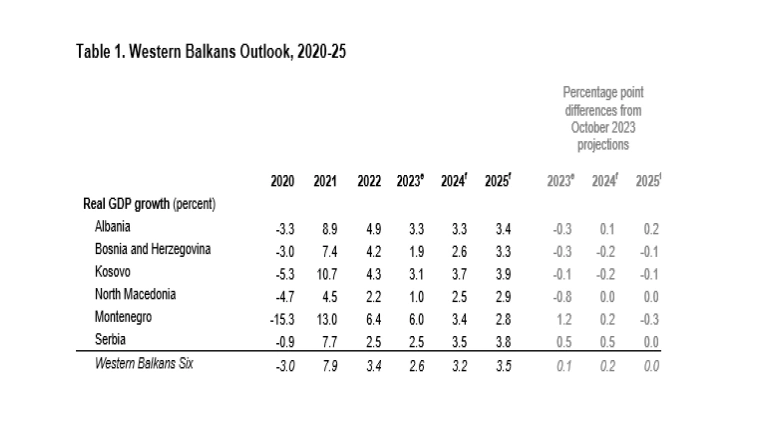
The report emphasizes the need for reforms in fiscal, governance, education, and energy sectors to achieve economic convergence with the European Union. It notes the opportunity to stimulate growth through investments in the green economy, creating more compact cities, expanding public transportation, and taking measures to adapt to climate change. The €6 billion Growth Plan for the region aims to strengthen economic integration with the EU and enhance regional ties.
While progress is encouraging, the report notes that current growth is insufficient to meet citizens’ aspirations for living standards on par with EU standards. Further efforts are needed to close the development gap and support sustainable growth in the Western Balkans.
Thus, Belarusian economic experts are wrong in their judgments about Kosovo’s economy:
Bosnia and Herzegovina itself — together with Macedonia and Kosovo — make up a group of unsuccessful (economically speaking) fragments of the former Yugoslavia. And if Belarus today is not in last place in terms of GDP per capita in Europe, it is only because there is war-torn Ukraine, Moldova, and such “fragments.” Nevertheless, this leader of even a small but European region visited Moscow in May 2023, shook hands with an elderly historian, called the Russian invasion a forced measure, and promised not to participate in anti-Russian sanctions.
Here is a comparison of some data between Belarus and Kosovo: 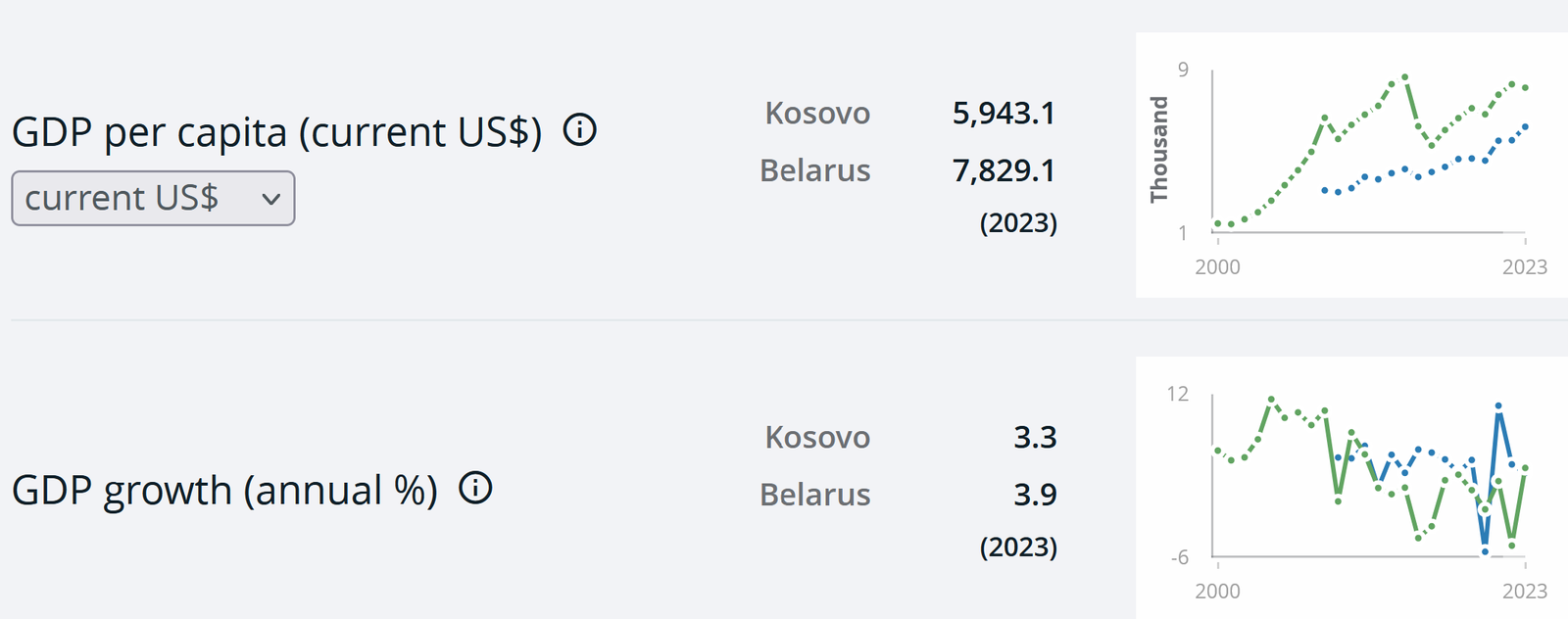
 Foreign direct investment in Kosovo shows significant growth compared to that in the Belarusian economy.
Foreign direct investment in Kosovo shows significant growth compared to that in the Belarusian economy.
Of course, toxic Telegram channels made various kinds of conspiracy publications, such as about “organ trafficking,” drug trafficking, car theft, and so on.
Conclusion: Belarusian propaganda Telegram channels, in unison with Russian ones, actively use stereotypes about Kosovo that have developed since the late 1990s to justify the aggressive actions of the Russian Federation, including the invasion of Ukraine. These narratives include references to Russian involvement in KFOR and the symbolic seizure of the airport in Pristina, which are presented as historical evidence of Russia’s right to intervene in international affairs. The topic of Serbia is used to create an illusion of historical justice and fraternal ties, which helps form the narrative of “protecting” Russian-speaking and Orthodox peoples. This approach allows Belarusian propagandists to strengthen anti-Western sentiments and legitimize Russia’s aggressive foreign policy moves.
This publication was developed by a research team under the leadership of Mikhail Doroshevich, PhD.


